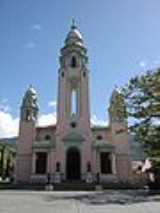
Panteón Nacional
Encyclopedia
The Panthéon is a building in the northern edge of the old town of Caracas
, Venezuela
. It was originally built as a church, but is now used as a famous burial place. The entire central nave is dedicated to Simón Bolívar
, with the altar's place taken by the hero's bronze sarcophagus, while lesser luminaries are relegated to the aisles. The national pantheon's vault is covered with 1930s paintings depicting scenes from Bolívar's life, and the huge crystal chandelier glittering overhead was installed in 1883 on the centennial of his birth.

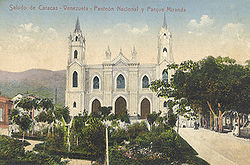 On 27 March 1874, president Antonio Guzmán Blanco
On 27 March 1874, president Antonio Guzmán Blanco
decreed the transformation of the Santísima Trinidad church of Caracas into a National Pantheon, to conserve the remains of the heroes of Independence and those of eminent people. This church was constructed by Juan Domingo del Sacramento Infante in the middle of the 17'th century, the 1812 earthquake
destroyed it almost totally, its slow reconstruction continued under the direction of several engineers and when was decree as Pantheon, it was still not finished.
The choice of this temple for so lofty a destiny was motivated as much by its then-panoramic and distant position from the urban nucleus of Caracas, as by its historical antecedents, during the return of Simón Bolívar's remains from Santa Marta in 1842, they were deposited temporarily at this church. In the church were also buried, in 1851, the remains of Francisco Rodríguez del Toro (Marqués del Toro), those of José Gregorio Monagas
, Andrés Ibarra and Ezequiel Zamora
. The decree of Guzmán Blanco was accompanied with the order of the completion of its facades, being finished the project made by engineer José Gregorio Solano during 1853-1858. It was the first design of neogothic architecture in Venezuela, consisted of a symmetrical facade of three doors and two angular towers. The works were led, successively, by the engineers Julian Churión, Juan Hurtado Manrique, Tomás Soriano and Roberto García, finishing on 28 October 1875. Nevertheless, the inauguration of the building occurred during St. Simon's day, when the remains of the Liberator were transferred from the cathedral. These were placed in a wooden sarcophagus with silver and gold coating, made in a neogothic style by the French engraver Emile Jacquin. The statue of the Liberator executed in 1842 by the Italian sculptor Pietro Tenerani was also transferred from the cathedral. The sarcophagus and the statue were placed in the space that was used by the priest of the church. From the ceiling, a crystal chandelier from Bacarat with 230 lights was hung. In 1910, the government of Juan Vicente Gómez
undertook a general renovation of the building, following the plans of architect Alejandro Chataing
. Some changes to the facade were introduced, and the inner decoration was modified, placing a sky-light in the ceiling of the nave.
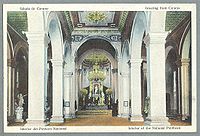 The floor was paved with white, gray and black marble slabs. These works were finished in 1911, on the occasion of the centenary of Independence.
The floor was paved with white, gray and black marble slabs. These works were finished in 1911, on the occasion of the centenary of Independence.
Another redesign of the Pantheon was ordered during Gómez government in 1929, according to the plans of architect Manuel Mujica Millán. This consisted of a radical change in the facades to a neocolonial and neobaroque design, adding in the front a third central tower 48 m high and replacing the lateral ones by others, all constructed of reinforced concrete. Also a new porch with a single entrance was added. The height of the lateral facades was increased, opening the windows in harmony with the internal chapels. Also, the entrance stairs were extended and made the more monumental. These works, which gave the building its present aspect, were undertaken during the year 1930 under the direction of Mujica and the engineers Edgar Pardo, Hernán Ayala and Guillermo Salas. Internally, corrections were made in the arches and the columns. The old wooden sarcophagus that contained the remains of El Libertador
was replaced by one of bronze, designed by Spanish sculptor Chicharro Gamo and placed on a marble plinth. The previous marble pavement was replaced, the wooden ceilings were also replaced. The upper part of the nave and of the arches were covered by paintings with allegorical and historical subjects by painter Tito Salas
.
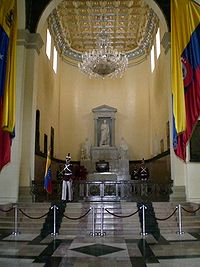
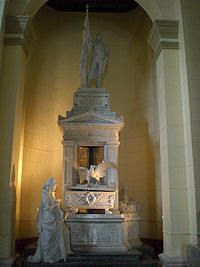


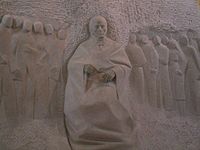
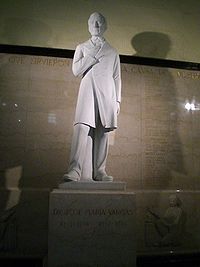
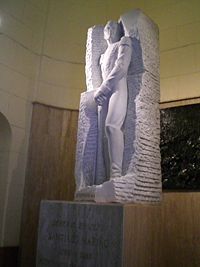


 Inside the Pantheon, on both sides of the main recess that contains the tomb and monument to the Liberator, there are the statues of Francisco de Miranda
Inside the Pantheon, on both sides of the main recess that contains the tomb and monument to the Liberator, there are the statues of Francisco de Miranda
and Antonio José de Sucre
, respectively. Along the whole of the side walls, there are monuments dedicated to the First Republic, José Gregorio Monagas
, Andrés Bello
, José Antonio Páez
, Rafael Urdaneta
and José María Vargas
and other important Venezuelan people. Under the pavement, in the two side caissons the remains of famous and illustrious Venezuelans are placed, labelled by tablets.
In 1963 the government decreed a regulation, establishing that the building must be opened to the public every day of the year. At the same time, the administration of the graves and other procedures are responsibility of the Ministry of Interior. In 1980, city-planning works to remodel the surroundings of the Pantheon were initiated in accordance with the study of architect Tomás Sanabria.
The following personalities in the preceding list are not buried in the Pantheon because their remains have not been found, but it has been decreed by the Venezuelan authorities they should be:
The following person is not buried in the Pantheon but an empty tomb is kept there, next to Simon Bolivar's in the hopes that his remains will return to his homeland:
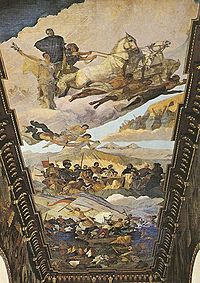
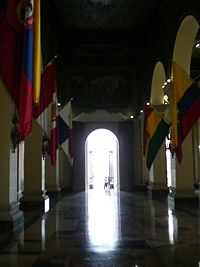 Central Nave
Central Nave
Right Nave
Left Nave
Caracas
Caracas , officially Santiago de León de Caracas, is the capital and largest city of Venezuela; natives or residents are known as Caraquenians in English . It is located in the northern part of the country, following the contours of the narrow Caracas Valley on the Venezuelan coastal mountain range...
, Venezuela
Venezuela
Venezuela , officially called the Bolivarian Republic of Venezuela , is a tropical country on the northern coast of South America. It borders Colombia to the west, Guyana to the east, and Brazil to the south...
. It was originally built as a church, but is now used as a famous burial place. The entire central nave is dedicated to Simón Bolívar
Simón Bolívar
Simón José Antonio de la Santísima Trinidad Bolívar y Palacios Ponte y Yeiter, commonly known as Simón Bolívar was a Venezuelan military and political leader...
, with the altar's place taken by the hero's bronze sarcophagus, while lesser luminaries are relegated to the aisles. The national pantheon's vault is covered with 1930s paintings depicting scenes from Bolívar's life, and the huge crystal chandelier glittering overhead was installed in 1883 on the centennial of his birth.
History


Antonio Guzmán Blanco
Antonio Leocadio Guzmán Blanco was President of Venezuela for three separate terms, from 1870–1877, from 1879–1884, and from 1886–1887....
decreed the transformation of the Santísima Trinidad church of Caracas into a National Pantheon, to conserve the remains of the heroes of Independence and those of eminent people. This church was constructed by Juan Domingo del Sacramento Infante in the middle of the 17'th century, the 1812 earthquake
1812 Caracas earthquake
The 1812 Caracas earthquake took place in Venezuela on March 26, 1812 at 4:37 p.m. It measured 7.7 on the Richter magnitude scale. It caused extensive damage in Caracas, La Guaira, Barquisimeto, San Felipe, and Mérida...
destroyed it almost totally, its slow reconstruction continued under the direction of several engineers and when was decree as Pantheon, it was still not finished.
The choice of this temple for so lofty a destiny was motivated as much by its then-panoramic and distant position from the urban nucleus of Caracas, as by its historical antecedents, during the return of Simón Bolívar's remains from Santa Marta in 1842, they were deposited temporarily at this church. In the church were also buried, in 1851, the remains of Francisco Rodríguez del Toro (Marqués del Toro), those of José Gregorio Monagas
José Gregorio Monagas
José Gregorio Monagas was President of Venezuela 1851-1855 and brother of José Tadeo Monagas.General José Gregorio Monagas was born in Aragua de Barcelona, Venezuela, in 1795. His parents were Francisco José Monagas, a merchant from the Canary Islands, and Perfecta Burgos, a native of Cojedes...
, Andrés Ibarra and Ezequiel Zamora
Ezequiel Zamora
Ezequiel Zamora , 1 February 1817 - 10 January 1860) was a Venezuelan soldier and leader of the Federalists in the Federal War of 1859-1863. His life was marked by the romanticism that characterized liberals of the time....
. The decree of Guzmán Blanco was accompanied with the order of the completion of its facades, being finished the project made by engineer José Gregorio Solano during 1853-1858. It was the first design of neogothic architecture in Venezuela, consisted of a symmetrical facade of three doors and two angular towers. The works were led, successively, by the engineers Julian Churión, Juan Hurtado Manrique, Tomás Soriano and Roberto García, finishing on 28 October 1875. Nevertheless, the inauguration of the building occurred during St. Simon's day, when the remains of the Liberator were transferred from the cathedral. These were placed in a wooden sarcophagus with silver and gold coating, made in a neogothic style by the French engraver Emile Jacquin. The statue of the Liberator executed in 1842 by the Italian sculptor Pietro Tenerani was also transferred from the cathedral. The sarcophagus and the statue were placed in the space that was used by the priest of the church. From the ceiling, a crystal chandelier from Bacarat with 230 lights was hung. In 1910, the government of Juan Vicente Gómez
Juan Vicente Gómez
Juan Vicente Gómez Chacón was a military general and de facto ruler of Venezuela from 1908 until his death in 1935. He was president on three occasions during this time, and ruled as an unelected military strongman for the rest of the era.-Early years:Gómez was a barely literate cattle herder and...
undertook a general renovation of the building, following the plans of architect Alejandro Chataing
Alejandro Chataing
Alejandro Chataing was an important Venezuelan architect. Chataing was known as the "great constructor of the regime of Cipriano Castro." He was a prolific architect who helped give Caracas a new face.-Introduction:In general, his projects demonstrated a remarkable eclecticism, with tendencies...
. Some changes to the facade were introduced, and the inner decoration was modified, placing a sky-light in the ceiling of the nave.

Another redesign of the Pantheon was ordered during Gómez government in 1929, according to the plans of architect Manuel Mujica Millán. This consisted of a radical change in the facades to a neocolonial and neobaroque design, adding in the front a third central tower 48 m high and replacing the lateral ones by others, all constructed of reinforced concrete. Also a new porch with a single entrance was added. The height of the lateral facades was increased, opening the windows in harmony with the internal chapels. Also, the entrance stairs were extended and made the more monumental. These works, which gave the building its present aspect, were undertaken during the year 1930 under the direction of Mujica and the engineers Edgar Pardo, Hernán Ayala and Guillermo Salas. Internally, corrections were made in the arches and the columns. The old wooden sarcophagus that contained the remains of El Libertador
Simón Bolívar
Simón José Antonio de la Santísima Trinidad Bolívar y Palacios Ponte y Yeiter, commonly known as Simón Bolívar was a Venezuelan military and political leader...
was replaced by one of bronze, designed by Spanish sculptor Chicharro Gamo and placed on a marble plinth. The previous marble pavement was replaced, the wooden ceilings were also replaced. The upper part of the nave and of the arches were covered by paintings with allegorical and historical subjects by painter Tito Salas
Tito Salas
Británico Antonio Salas Díaz, better known as Tito Salas , was a Venezuelan painter.His father, José Antonio Salas, was one of the first traders who established a brewery in Venezuela. The studies of Tito, began in the Academy of Fine Arts of Caracas...
.
National Pantheon










Francisco de Miranda
Sebastián Francisco de Miranda Ravelo y Rodríguez de Espinoza , commonly known as Francisco de Miranda , was a Venezuelan revolutionary...
and Antonio José de Sucre
Antonio José de Sucre
Antonio José de Sucre y Alcalá , known as the "Gran Mariscal de Ayacucho" , was a Venezuelan independence leader. Sucre was one of Simón Bolívar's closest friends, generals and statesmen.-Ancestry:...
, respectively. Along the whole of the side walls, there are monuments dedicated to the First Republic, José Gregorio Monagas
José Gregorio Monagas
José Gregorio Monagas was President of Venezuela 1851-1855 and brother of José Tadeo Monagas.General José Gregorio Monagas was born in Aragua de Barcelona, Venezuela, in 1795. His parents were Francisco José Monagas, a merchant from the Canary Islands, and Perfecta Burgos, a native of Cojedes...
, Andrés Bello
Andrés Bello
Andrés de Jesús María y José Bello López was a Venezuelan humanist, poet, lawmaker, philosopher, educator and philologist, whose political and literary works constitute an important part of Spanish American culture...
, José Antonio Páez
José Antonio Páez
José Antonio Páez Herrera was General in Chief of the army fighting Spain during the Venezuelan Wars of Independence, in addition to becoming the President of Venezuela once it was independent of the Gran Colombia...
, Rafael Urdaneta
Rafael Urdaneta
Rafael José Urdaneta y Faría was a Venezuelan General and hero of the Spanish American wars of independence in several countries in northern South America.- Biographic data :...
and José María Vargas
José María Vargas
José María Vargas was the 4th President of Venezuela from 1835–1836.-Life and career:...
and other important Venezuelan people. Under the pavement, in the two side caissons the remains of famous and illustrious Venezuelans are placed, labelled by tablets.
In 1963 the government decreed a regulation, establishing that the building must be opened to the public every day of the year. At the same time, the administration of the graves and other procedures are responsibility of the Ministry of Interior. In 1980, city-planning works to remodel the surroundings of the Pantheon were initiated in accordance with the study of architect Tomás Sanabria.
List of personalities who are buried at the Pantheon
- Cecilio Acosta. Writer, journalist and humanist. (5 July 1937).
- José Ángel de Álamo. Doctor, leader of the Independence movement. (9 May 1876).
- Francisco de Paula Alcántara. General in the War of Independence. (6 June 1876).
- Demetrio Alfaro. Officer in the War of Independence. (28 May 1876).
- Lisandro Alvarado. Doctor. (14 May 1980).
- Raimundo Andueza. Lawyer, soldier and politician, father of President Raimundo Andueza Palacio. (2 September 1881).
- Francisco Aranda. Politician. (18 May 1898).
- Juan Bautista ArismendiJuan Bautista ArismendiJuan Bautista Arismendi was a Venezuelan patriot and general of the Venezuelan War of Independence. He is buried in the National Pantheon of Venezuela.Arismendi was born in Isla Margarita in 1775...
. Officer in the War of Independence. (29 January 1877). - Jesús María Aristiguieta. Military and politician in the War of Independence. (18 March 1890).
- Carlos Arvelo. Doctor and politician. (16 December 1942).
- Rafael Arvelo. Journalist. (12 July 1877).
- Francisco de Paula Avendaño. Officer in the War of Independence. (16 March 1966).
- Rafael María BaraltRafael María BaraltRafael María Baralt y Pérez was a Venezuelan diplomat, writer and historian. He was the first Latin American to occupy a chair at the Real Academia Española...
. Writer and historian; ambassador to Spain. (23 November 1982). - José Miguel Barceló. Military of the Federal War. (14 May 1878).
- Pedro Bárcenas. Doctor and officer in the War of Independence. (5 November 1877).
- Víctor Barret de Nazarís. Military and politician of the Federal War. (25 August 1896).
- Renato Beluche. Sailor in the Venezuelan Navy during the War of Independence. (22 July 1963).
- José Francisco BermúdezJosé Francisco BermúdezJosé Francisco Bermúdez was a Venezuelan who fought in the Venezuelan War of Independence, reaching the rank of General. He is buried in the National Pantheon of Venezuela....
. Officer in the War of Independence. (24 October 1877). - Pedro Bermúdez Cousín. Lawyer, soldier and politician. (30 December 1875).
- Andrés Eloy BlancoAndrés Eloy BlancoAndrés Eloy Blanco Meaño was an important Venezuelan poet, politician, member of the Generación del 28, and one of the founders of Acción Democrática ....
. Poet and politician. (2 July 1981). - José Félix Blanco. Priest. (3 July 1896).
- Manuel Blanco. Sailor who fought with San Martín and Simón Bolívar. (15 April 1876).
- Rufino Blanco Fombona. Writer and politician. (23 June 1975).
- Simón BolívarSimón BolívarSimón José Antonio de la Santísima Trinidad Bolívar y Palacios Ponte y Yeiter, commonly known as Simón Bolívar was a Venezuelan military and political leader...
. Liberator of Bolivia, Colombia, Ecuador, Peru, Panama and Venezuela. (28 October 1876). - Justo Bricéño. Officer in the War of Independence. (21 May 1876).
- Mario Briceño IragorryMario Briceño IragorryMario Briceño Iragorry , was a Venezuelan intellectual and cultural analyst. He was also a notable writer, politician, journalist, lawyer, historian, diplomatic and teacher. He won the National Prize for Literature in 1948...
. Historian, writer and diplomat. (6 March 1991). - Domingo Briceño y Briceño. Lawyer, journalist and writer. (6 May 1876).
- Luis BriónLuis BriónPedro Luis Brión was a military officer who fought in the Venezuelan War of Independence. He rose to the rank of admiral in the navies of Venezuela and the old Republic of Colombia.-Early career:...
. Official of the Venezuelan Navy. (10 April 1882). - Blas Bruzual. Military, politician and journalist. (16 August 1889).
- Manuel Ezequiel BruzualManuel Ezequiel BruzualManuel Ezequiel Bruzual , was a military leader committed to liberal ideas, also in charge of the War and Navy Ministry in 1864, and in 1868 was designated provisional President of Venezuela.Bruzual participated actively in the Federal War, being known as the Courageous soldier of Federation,...
. Military and politician. (13 November 1872). - Lorenzo Bustillos. Officer in the War of Independence. (17 February 1877).
- Luisa Cáceres de ArismendiLuisa Cáceres de ArismendiMaría Luisa Cáceres Díaz de Arismendi was a heroine of the Venezuelan War of Independence.-The beginning of the war:...
. Patriot and Heroine of the Venezuelan War of Independence. (14 August 1876). - Josefa Venancio de la Encarnación Camejo. Heroine in the War of Independence.
- Francisco Carabaño Aponte. Officer in the War of Independence. (18 May 1876).
- Teresa CarreñoTeresa CarreñoMaría Teresa Carreño García de Sena was a Venezuelan pianist, singer, composer, and conductor.Born into a musical family, she was at first taught by her father, then by Mathias, Louis Moreau Gottschalk and Anton Rubinstein and her talent was recognized at an early age...
. Pianist and composer. (9 December 1977). - José de la Cruz Carrillo. Officer in the War of Independence. (15 December 1971).
- Carlos Luis Castelli. Officer in the War of Independence. (11 May 1876).
- Juan Francisco del Castillo. Lawyer, military and politician. (2 July 1893).
- Cipriano CastroCipriano CastroJosé Cipriano Castro Ruiz was a high ranking member of the Venezuelan military, politician and the President of Venezuela from 1899 to 1908...
. Military and President of Venezuela. (6 December 2002). - Manuel Cedeño. Officer in the War of Independence. (16 December 1942).
- Lino de Clemente. Official of the Venezuelan navy. (21 July 1961).
- Agostino CodazziAgostino CodazziGiovanni Battista Agostino Codazzi was an Italian soldier, scientist, geographer and cartographer...
. Military, scientist, geographer and cartographer.(16 December 1942). - Juan Fermín Colmenares. Military and politician at the Federal War. (20 August 1881).
- Juan José Conde. Officer in the War of Independence. (19 May 1876).
- José María Delgado Correa. (20 May 1876).
- Manuel María Echeandía. (18 April 1876).
- Juan Crisóstomo FalcónJuan Crisóstomo FalcónJuan Crisóstomo Falcón y Zavarce , was the 20th President of Venezuela as well as military commander during the Federal War. Member of the Liberal party, first served as the supreme chief of a rebel movement in August 1859, but the rebellion was soon crushed. After the Coche treaty, is recognized...
. Soldier, politician, and President of Venezuela. (1 May 1874). - León de Febres Cordero. Officer in the War of Independence. (16 December 1942).
- Carmelo FernándezCarmelo FernándezCarmelo Fernández was a Venezuelan painter and illustrator. When Simon Bolivar's remains were returned to Venezuela, he made sketches of the event; he also illustrated an atlas by Agostino Codazzi, and provided portraits for the Resumen de la historia de Venezuela, published in...
. Officer in the War of Independence. (18 August 1983). - Fernando Figueredo. Officer in the War of Independence. (29 June 1937).
- Alejo Fortique. Politician and diplomat. (30 April 1876).
- Rómulo GallegosRómulo GallegosRómulo Ángel del Monte Carmelo Gallegos Freire was a Venezuelan novelist and politician. For a period of some nine months during 1948, he was the first cleanly elected president in his country's history....
. Writer and politician, President of Venezuela. (3 May 1994). - Juan Garcés. Soldier in the war of Independence. (26 November 1934).
- José María García. Navy officer in the War of Independence. (15 August 1896).
- Valentín García. Officer in the War of Independence. (27 April 1961).
- Miguel Gil. Soldier in the War of Independence. (5 August 1876).
- Francisco Esteban Gómez. Officer in the War of Independence. (20 August 1881).
- José de Jesús González. Military leader of the Federal War. (22 April 1897).
- Tomás Green. (24 August 1876).
- GuaicaipuroGuaicaipuroGuaicaipuro was a native Venezuelan chief of both the Teques and Caracas tribes. Though known today as Guaicaipuro, in documents of the time his name was written Guacaipuro.-Life:...
. Indigenous chief. (9 December 2001). - Juan Bautista Guerra Carrillo.
- Manuel María Guevara. (10 August 1877).
- Antonio Leocadio Guzmán. Politician and journalist. (18 November 1884).
- Antonio Guzmán BlancoAntonio Guzmán BlancoAntonio Leocadio Guzmán Blanco was President of Venezuela for three separate terms, from 1870–1877, from 1879–1884, and from 1886–1887....
. Military, lawyer and President of Venezuela. (1999). - Tomás de Heres. Officer in the War of Independence. (16 December 1942).
- Francisco Hurtado. (26 May 1876).
- Andrés Ibarra. Officer in the War of Independence. (24 August 1875).
- Diego Ibarra. Officer in the War of Independence. (20 October 1876).
- Francisco de Ibarra. Priest. (9 November 1880).
- Juan Domingo del Sacramento Infante. Bricklayer, constructor of the Santísima Trinidad Church (Current National Pantheon). (13 December 1780).
- Tomás Lander. Journalist, farmer, politician, and propagator of Venezuelan liberal thought. (5 April 1884).
- José Prudencio Lanz. (21 April 1876).
- Jacinto LaraJacinto LaraJacinto Lara , was a Venezuelan independence leader and hero of the Venezuelan War of Independence. His contribution included participating in Simón Bolívar's 1813 Admirable Campaign. He was briefly Prefect of the Intendency of the Magdalena River and the Isthmus in 1821...
. Officer in the War of Independence. (24 July 1911). - Francisco Lazo Martí. Doctor and poet. (27 October 1983).
- Andrés Olimpo Level. Magistrate, lawyer, politician and journalist. Active in the War of Independence. (28 November 1876).
- Francisco Linares AlcántaraFrancisco Linares AlcántaraFrancisco de Paula Linares Alcántara was President of Venezuela and a member of the Liberal Party of Venezuela, military and Venezuelan politician, president of the Republic , Congress gave him the title of “the Great Democrat”Francisco Linares, spent his childhood in the town of Turmero...
. Soldier and politician, President of Venezuela. (4 December 1878). - Enrique Luzón. German-born and originally named Heinrich von Lützow Officer in the War of Independence. (12 December 1877).
- José Tomás Machado. Official of the Venezuelan Navy. (16 December 1942).
- Vicente Marcano. Engineer, chemist and geologist. (10 July 1991).
- Santiago MariñoSantiago MariñoSantiago Mariño , was a nineteenth-century Venezuelan revolutionary leader and hero in the Venezuelan War of Independence...
. Officer in the War of Independence. (1 January 1877). - Zoilo Medrano. Farmer leader of the Federal War. (22 April 1897).
- Ramón Ignacio Méndez de la Barta. Priest, lawyer and politician during the Independence War.(16 December 1942).
- Arturo MichelenaArturo MichelenaArturo Michelena was a Venezuelan painter born in Valencia, Carabobo State. He began to paint at a young age under his father's tutelage. Traveled to Paris where he studied in the famous Académie Julian...
. Painter. (29 July 1948). - Guillermo Michelena Salías. Doctor, university professor, and science writer. (10 November 1891).
- Carlos Minchin. Officer in the War of Independence. (4 June 1879).
- José Gregorio MonagasJosé Gregorio MonagasJosé Gregorio Monagas was President of Venezuela 1851-1855 and brother of José Tadeo Monagas.General José Gregorio Monagas was born in Aragua de Barcelona, Venezuela, in 1795. His parents were Francisco José Monagas, a merchant from the Canary Islands, and Perfecta Burgos, a native of Cojedes...
. General in the War of Independence, President of Venezuela, Liberator of the slaves. (13 November 1872). - José Tadeo MonagasJosé Tadeo MonagasJosé Tadeo Monagas Burgos was President of Venezuela 1847-1851 and 1855–1858, and a hero of the Venezuelan War of Independence...
. Military leader, President of Venezuela. (17 May 1877). - Mariano MontillaMariano MontillaMariano Montilla was a Major General of the Army of Venezuela in the Venezuelan War of Independence.-Youth:Montilla was born at Caracas.As a young man he went to Spain where he joined the American bodyguard company...
. Officer in the War of Independence. (3 July 1896). - Juan de Dios Monzón. Doctor, soldier and politician. (20 April 1876).
- José Trinidad Morán. Writer and officer in the War of Independence. (3 December 1954).
- Tomás Muñoz y Ayala. (14 June 1892).
- Pedro Navarro Bolet. (29 January 1878).
- Carlos Núñez. Member of the Patriotic Society during the Independence. (17 February 1877).
- Daniel Florencio O'LearyDaniel Florencio O'LearyDaniel Florence O'Leary was a military general and aide-de-camp under Simón Bolívar. He was born in Cork, Ireland; his father was Jeremiah O'Leary, a butter merchant...
. Irish officer serving in the Venezuelan and Colombian army during the War of Independence. (10 April 1882). - Manuel Germán Ojeda Muñiz. (20 December 1875).
- José Manuel Olivares. Officer in the War of Independence. (14 May 1876).
- José Antonio PáezJosé Antonio PáezJosé Antonio Páez Herrera was General in Chief of the army fighting Spain during the Venezuelan Wars of Independence, in addition to becoming the President of Venezuela once it was independent of the Gran Colombia...
. General-in-Chief of Venezuelan Independence. (19 April 1888). - Miguel Palacio Fajardo. Doctor and lawyer. Officer in the War of Independence. (1876).
- Juan Antonio Paredes Angulo. Officer in the War of Independence. (16 September 1960).
- Francisco Vicente Parejo. Officer in the War of Independence. (18 May 1876).
- Ana Teresa Parra SanojoTeresa de la Parra-Life:She was born Ana Teresa Parra Sanojo in Paris, the daughter of Rafael Parra Hernáiz, Venezuelan Ambassador in Berlin, and Isabel Sanojo de Parra.As a member of a wealthy family, Ana Teresa spent part of her childhood at her father's hacienda, Tazón...
. Writer. (7 November 1989). - Jesús María Paúl. (11 February 1877).
- Miguel PeñaMiguel PeñaMiguel Peña is by far the largest civil parish in the municipality of Valencia, Carabobo, and one of the most populous in Venezuela.It is located in the Southern part of the city and it has most of Valencia's poorest slums...
. Lawyer and politician. (24 July 1911). - Fernando PeñalverFernando PeñalverFernando Peñalver , was a Venezuelan independence leader and hero of the Venezuelan War of Independence. He was the first governor of the Province of Carabobo . He is buried in the National Pantheon of Venezuela.- See also :...
. Signer of the Act of Independence. (3 July 1896). - Juan Antonio Pérez BonaldeJuan Antonio Pérez BonaldeJuan Antonio Pérez Bonalde was a Venezuelan translator and poet. He is buried in the National Pantheon of Venezuela.-Life:Juan Antonio Pérez Bonalde was born in Caracas, Venezuela, in 1846. He lived many years in exile, due to political problems his family had with the government of that time...
. Poet. (14 February 1946). - Gabriel Picón González. Officer in the War of Independence. (23 June 1975).
- Judas Tadeo Piñango. Officer in the War of Independence. (16 December 1942).
- Simón Planas. Politician. (26 August 1877).
- José Ignacio Pulido del Pumar. Officer in the War of Independence. (15 January 1881).
- José Luis Ramos. Humanist, founder of the Literary journalism. (16 August 1889).
- Rafael Rangel. Scientist who studied tropical diseases. (20 August 1977).
- Luis RazettiLuis RazettiLuis Razetti was a Venezuelan physician....
. Doctor and surgeon. (23 June 1982). - José Rafael RevengaJosé Rafael RevengaThe José Rafael Revenga Municipality is one of the 18 municipalities that makes up the Venezuelan state of Aragua and, according to a 2007 population estimate by the National Institute of Statistics of Venezuela, the municipality has a population of 49,593. The town of El Consejo is the shire...
. Lawyer. (22 December 1969). - Pedro Rodríguez. (12 December 1879).
- Simón RodríguezSimón RodríguezSimón Rodríguez , known during his exile from Spanish America as Samuel Robinson, was a South American philosopher and educator, notably Simón Bolívar's tutor and mentor....
. Bolívar's teacher. (28 February 1954). - Francisco Rodríguez del Toro. Officer in the War of Independence. (9 May 1851)
- Donato Rodríguez Silva. Military and politician of the Federal War. (22 April 1897).
- Arístides Rojas. Naturalist. (22 September 1983).
- Cristóbal RojasCristóbal RojasCristóbal Rojas was one of the most important and high-profile Venezuelan painters of the 19th century...
. Painter. (27 December 1958). - Pedro Manuel Rojas Mercado. Military leader of the Federal War. (10 August 1876).
- Juan José Rondón. Officer in the War of Independence. (25 August 1896).
- Bartolomé Salom. Officer in the War of Independence. (5 July 1909).
- Tomás José Sanabria y Meleán. Lawyer and politician. (1 January 1896).
- Luis Sanojo. Lawyer and politician. (22 June 1978).
- José Laurencio Silva. Officer in the War of Independence. (16 December 1942).
- Juan Antonio SotilloJuan Antonio SotilloGeneral Juan Antonio Sotillo was a nineteenth century military leader from Venezuela. During his long life, a very uncommon circumstance for a military leader at the time, he served under the army of Venezuelan general Simón Bolívar, as well as in most of the Venezuelan nineteenth century civil...
. Officer in the War of Independence. (9 January 1878). - Carlos SoubletteCarlos SoubletteCarlos Soublette was President of Venezuela 1837-1839 and 1843–1847, and a hero of the Venezuelan War of Independence....
. Officer in the War of Independence, President of Venezuela. (7 February 1970). - Fermín ToroFermín ToroFermín Toro y Blanco was a politician, diplomat and author. His remains were located at the Panteón Nacional on 23 April 1876...
. Politician and diplomatic. (23 April 1876). - Pedro León Torres. Officer in the War of Independence. (16 August 1889).
- Martín Tovar y TovarMartín Tovar y TovarMartín Tovar y Tovar was one of the most important and high-profile Venezuelan painters of the 19th century. Tovar y Tovar's most famous work is his famous and well-known depiction of the Battle of Carabobo...
. Painter. (22 September 1983). - José Vicente de Unda. Priest. (16 December 1942).
- Diego Bautista Urbaneja Sturdy. Lawyer and colonel. (22 October 1876).
- Adolfo Urdaneta. Son of Rafael Urdaneta. (24 November 1876)
- Rafael UrdanetaRafael UrdanetaRafael José Urdaneta y Faría was a Venezuelan General and hero of the Spanish American wars of independence in several countries in northern South America.- Biographic data :...
. Officer in the War of Independence. (16 May 1876). - Wenceslao Urrutia. Lawyer and politician. (20 April 1876).
- Juan Uslar. German-born and originally named Johan Von Usler, in 1819 he brought more than 300 soldiers to aid the Venezuelans in their fight for independence. (16 December 1942).
- José María VargasJosé María VargasJosé María Vargas was the 4th President of Venezuela from 1835–1836.-Life and career:...
. Doctor and surgeon, President of Venezuela. (27 April 1877). - Miguel Antonio Vásquez. Officer in the War of Independence. (c. 1920).
- José Joaquín Veroes. Colonel in the War of Independence. (16 December 1942).
- Francisco Javier Yánez. (1876).
- José Ramón Yépez. Official of the Venezuelan Navy. (22 August 1949).
- Ezequiel ZamoraEzequiel ZamoraEzequiel Zamora , 1 February 1817 - 10 January 1860) was a Venezuelan soldier and leader of the Federalists in the Federal War of 1859-1863. His life was marked by the romanticism that characterized liberals of the time....
. Military leader of the Federal War. (13 November 1872) - Miguel Zárraga. Officer in the War of Independence. (10 May 1876).
The following personalities in the preceding list are not buried in the Pantheon because their remains have not been found, but it has been decreed by the Venezuelan authorities they should be:
- Francisco de MirandaFrancisco de MirandaSebastián Francisco de Miranda Ravelo y Rodríguez de Espinoza , commonly known as Francisco de Miranda , was a Venezuelan revolutionary...
. First leader of the Venezuelan Independence, participant at the American Revolutionary WarAmerican Revolutionary WarThe American Revolutionary War , the American War of Independence, or simply the Revolutionary War, began as a war between the Kingdom of Great Britain and thirteen British colonies in North America, and ended in a global war between several European great powers.The war was the result of the...
and the French RevolutionFrench RevolutionThe French Revolution , sometimes distinguished as the 'Great French Revolution' , was a period of radical social and political upheaval in France and Europe. The absolute monarchy that had ruled France for centuries collapsed in three years...
. - Josefa Camejo. Heroine of the Independence War.
- GuaicaipuroGuaicaipuroGuaicaipuro was a native Venezuelan chief of both the Teques and Caracas tribes. Though known today as Guaicaipuro, in documents of the time his name was written Guacaipuro.-Life:...
. Indigenous chief that fought against the Spaniards. - Manuel PiarManuel PiarManuel Carlos Piar was General-in-Chief of the army fighting Spain during the Venezuelan War of Independence.-Heritage and early life:...
. General in chief of the army during the Independence War.
The following person is not buried in the Pantheon but an empty tomb is kept there, next to Simon Bolivar's in the hopes that his remains will return to his homeland:
- Antonio José de SucreAntonio José de SucreAntonio José de Sucre y Alcalá , known as the "Gran Mariscal de Ayacucho" , was a Venezuelan independence leader. Sucre was one of Simón Bolívar's closest friends, generals and statesmen.-Ancestry:...
. Hero of the Independence War, founder and first President of Bolivia
Monuments


- Monument to Simón Bolívar by Pietro Tenerani.
Right Nave
- Monument to the First Republic by Hugo Daini.
- Monument to José Gregorio Monagas by Julio Roversi.
- Monumento to the Federation by Juan Bautista Sales Ferré.
Left Nave
- Monument to José Antonio Páez by José Pizzo.
- Monument to Rafael Urdaneta by Pietro Ceccarelli.
- Monument to José María Vargas by Franco Bianchinni.
- Monument to Santiago Mariño by Manuel de la Fuente.
Cenotaphs
- Cenotaph in honor of Francisco de Miranda by Julio Roversi.
- Cenotaph in honor to Antonio José de Sucre by Juan Bautista Sales Ferré.
- Cenotaph in honor to Andrés Bello by Manuel de la Fuente.
Works of Tito Salas
- Alegoría de la libertad de los esclavos.
- Apoteosis del Libertador. (1942)
- Bolívar en el Chimborazo.
- Bolívar y Humboldt en París.
- El ascenso al Cerro de Potosí el 26 de octubre de 1825.
- El tiempo graba el nombre de Bolívar para la posteridad.
- Entrada triunfal de Bolívar a Caracas después de la Batalla de Carabobo en 1821. (1935)
- Escudo de Caracas. (1942)
- Escudo de la familia Bolívar. (1942)
- Escudo de Venezuela. (1942)
- Fundación de Caracas. (1939)
- Inspiración del istmo de Panamá.
- Juramento de Bolívar en el monte Sacro.
- La noche de Casacoima.
- La Santísima Trinidad. (1933)
- Traslado de los restos del Libertador de la Guaira a Caracas en 1842. (1934)
- Unión, Unión.
See also
- CaracasCaracasCaracas , officially Santiago de León de Caracas, is the capital and largest city of Venezuela; natives or residents are known as Caraquenians in English . It is located in the northern part of the country, following the contours of the narrow Caracas Valley on the Venezuelan coastal mountain range...
- VenezuelaVenezuelaVenezuela , officially called the Bolivarian Republic of Venezuela , is a tropical country on the northern coast of South America. It borders Colombia to the west, Guyana to the east, and Brazil to the south...
- Panthéon, ParisPanthéon, ParisThe Panthéon is a building in the Latin Quarter in Paris. It was originally built as a church dedicated to St. Genevieve and to house the reliquary châsse containing her relics but, after many changes, now functions as a secular mausoleum containing the remains of distinguished French citizens...

